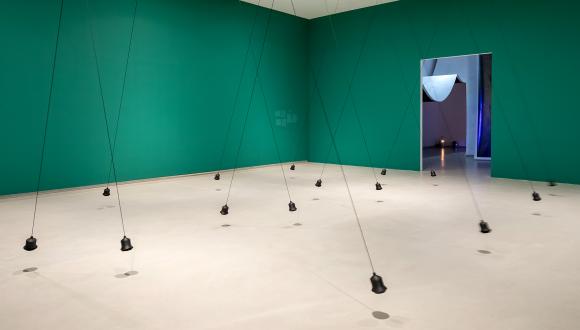Ronen Sharabani
Ronen Sharabani
Resonance 4145, 2023, Kinetic sound sculpture in 16 channels
A flock of pendulums sway back and forth in the gallery space; at first random and chaotic, over time they come together to form a wavy, harmonious, and continuous motion. This motion is accompanied by sounds of bats, recorded by Prof. Yossi Yovel, who studies mammalian perception and cognition. These sounds have been adapted to the human ear, but the space also contains other, inaudible sounds — additional layers and frequencies that unfold over time.
As we approach the end of an exhibition that is dedicated to various facets of the visible, Ronen Sharabani’s kinetic installation presents the question: Is it possible to see through sound? To hear an image? Bats possess this ability: They produce sounds while moving through space and use returning echoes to form an accurate image of their surroundings. The artist breaks down and reassembles these elements to create a setting where humans can hear the inaudible.
Sharabani often works with advanced technologies, including Machine Learning, to produce repetitive movements that offer a reexamination of the human perspective. Here, dancers have been replaced by technological pendulums, embodying the shifting relationship between the individual and the group, while forming new affinities between material, space, movement, and sound. The pendulums have tiny computerized motors, and they gradually learn how to operate through artificial intelligence. Adi Sharabani, Ronen's brother, wrote the code for this artwork so that every pendulum knows how to move independently as well as to synchronize with its neighbors and influence them. The visitors are invited to pick up an ultrasound detector and listen to the movement of this changing acoustic landscape. With that, Sharabani both points to the limitations of human perception and pushes its boundaries. The possibilities and frequencies of movement are defined by the dimensions of the space, encouraging us to adopt a new type of observation: If in the human experience sight is the dominant sense, here the auditory possibilities challenge it and conjure a new and unfamiliar sensory reality. And so, as the pendulums scatter and reconverge in the space, we can move in response to their resonance, and synchronize with their movement solely through the power of hearing.


